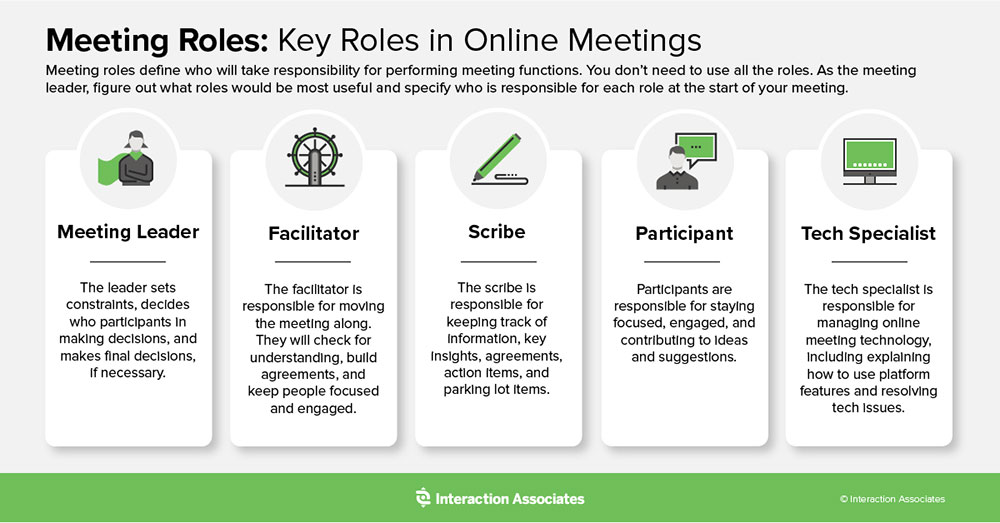Manufacturers can improve employee engagement and drive operational outcomes by improving meeting methodologies.
By Barry Rosen, Interaction Associates
The job of leading a team, function, or business unit has changed dramatically in the past year. Most prominently, the rapid transition to a hybrid workforce has made it more difficult to facilitate meaningful connections among disparate teams that need to communicate and collaborate to drive outcomes.
This is especially challenging for manufacturing leaders as the industry broadly struggles to generate effective employee engagement. For example, a Gallup poll revealed that only 25% of the manufacturing industry employees were engaged, 10% below the U.S. average for all industries.
As a result, companies are losing billions of dollars through lower employee retention, particularly among younger workers, hiring and assimilation costs, and productivity losses.
For leaders looking to optimize engagement at this critical time, improving meeting methodology and outcomes is a natural first step. Here are four ways that every leader can begin making meetings matter today.
Far too often, meeting leaders don’t have an agenda or have one that’s lacking important information. This means that a chunk of meeting time is spent getting attendees up to speed on this discussion. It also welcomes the likelihood of the topics at hand being derailed.
An effective meeting agenda includes two items: Purpose and Desired Outcomes.
Purpose
A meeting purpose should answer the question, “why meet?”. If you can’t answer this question, you may want to reevaluate having the meeting in the first place.
Common purposes include:
Desired Outcomes
Simply put, Desired Outcomes answer the question, “What will we be leaving this meeting with?” These are brief, written statements that are specific, measurable, and written from the participants’ perspective.

In the 2020 State of Online Meetings Report, it was found that meetings with clear agendas met their objectives 93% of the time. By improving meeting agendas, we increase the likelihood of having a productive use of time, rather than wasting another valuable hour of everyone’s day.
Use meetings as an opportunity to gain input and insight from a team of skilled experts in the organization. However, it’s likely that people will multi-task by checking emails or working on another project. To help mitigate this, the meeting leader or facilitator should check in with attendees throughout. As topics are discussed, always check for understanding before moving on to another topic.
Another way to keep attendees engaged in the meeting is to assign roles. When attendees play a part, they’re more likely to stay engaged. This takes the pressure off the meeting leader who can then focus more on the overall success.

Most organizations can’t eliminate meetings altogether. However, not all meetings are necessary. Most people have standing meetings to check in with direct reports, their team, or another individual. While these are valuable, they’re not always necessary. They’ll often turn into meetings just to meet, which yields unsuccessful results and wastes everyone’s time.
The meeting leader should check in with attendees beforehand on topics they want to cover. Then build out an agenda based on those topics and determine the amount of time needed to cover them. If there are no topics to cover, don’t meet. You may also find that the topics can easily be discussed over email, chat, or a quick phone call.
To successfully implement a change in the meeting culture, it’s important to hold everyone accountable. Some manufacturing leaders have explicitly told their employees to decline any meeting invite not accompanied by a purpose and desired outcome statements. In doing so, it demonstrated that leadership understood the value of their time and expected that it shouldn’t be wasted in a meeting set up for failure.
By making this statement, it forced everyone to actually think about why they’re having a meeting. If they can’t provide these basic items, they should not be holding a meeting in the first place. In fact, those that have implemented this direction to their employees have found a drastic decrease in unnecessary meetings and improved productivity.
When looking at cost-effective solutions to improve employee engagement, it’s important to understand your organization’s meeting culture. Plan out meetings rather than simply throwing an event on a calendar. Engage attendees by checking for understanding and assigning specific roles. Hold everyone accountable for improving the quality of meetings. If meetings are operating as more of a time suck than a productive use of time, employees become drained and frustrated. It’s time to re-think your approach and make meetings matter.

About the Author
Barry Rosen serves as the Chief Executive Officer of Interaction Associates, a pioneer in creative problem-solving, collaborative leadership, and group facilitation serving global manufacturers. As CEO, Barry’s mission is to empower associates to make decisions and provide services that help clients achieve their goals. Barry is the designer and developer of much of Interaction Associates’ intellectual content, including leadership, teamwork, and facilitation learning programs. He is also tasked with assembling the next generation of IA leaders and practitioners to bring The Interaction Method™ to companies and communities around the world. With more than 35 years in the learning and performance improvement industry, Barry has been a Senior Consultant at Interaction Associates, and Director of both the Training and Consulting Practices at IA.
Scott Ellyson, CEO of East West Manufacturing, brings decades of global manufacturing and supply chain leadership to the conversation. In this episode, he shares practical insights on scaling operations, navigating complexity, and building resilient manufacturing networks in an increasingly connected world.